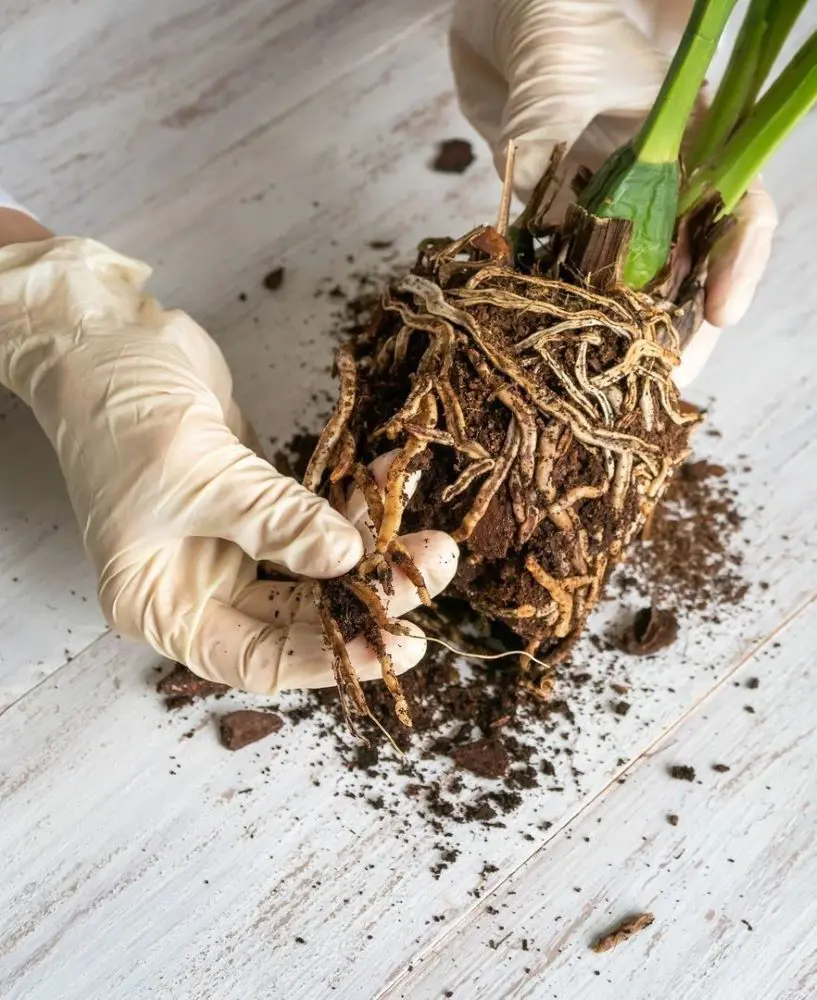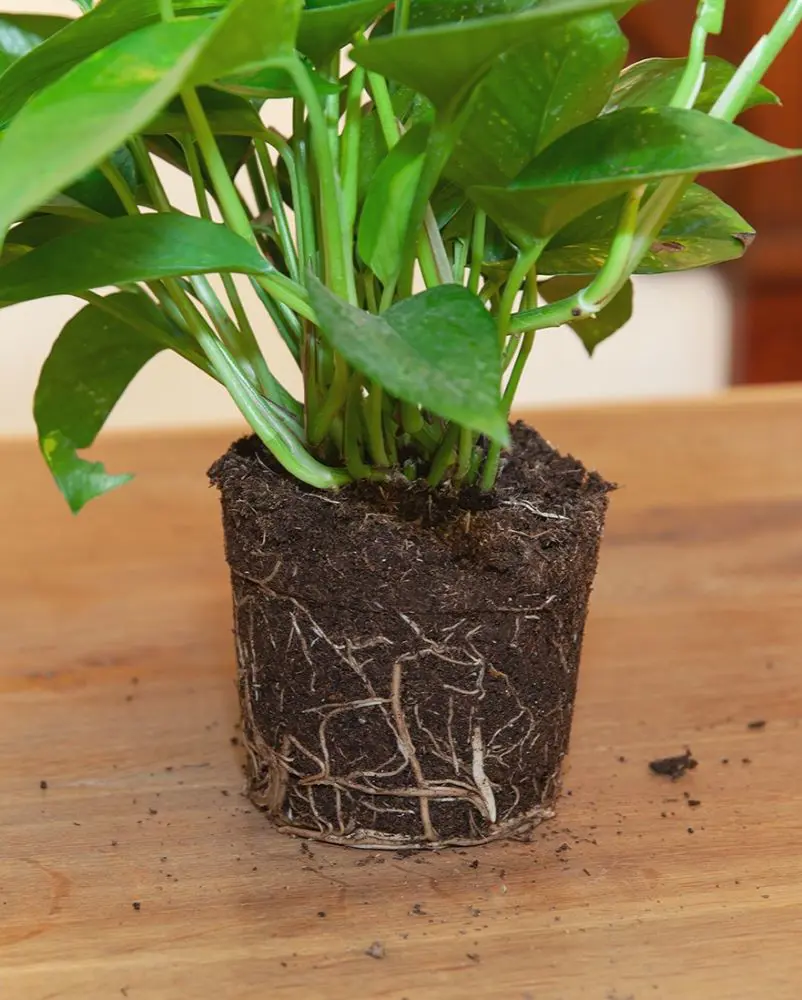Root Rot: How to Prevent, Identify And Fix It?

This post may contain affiliate links. If you make a purchase through links on our site, we may earn a commission.
Root rot poses a significant threat to the health and vitality of plants. This insidious disease, caused by various fungal pathogens, compromises the integrity of plant roots.
While no plant is immune to root rot, certain species are particularly susceptible, including pothos and peaceful lilies. Understanding the causes, signs, and preventative measures against root rot is paramount in safeguarding our green spaces and nurturing thriving plant life.
What Is A Root Rot?

Root rot is a fungal disease that affects plant roots, causing them to decay and become mushy. As the roots deteriorate, the plant's ability to absorb water and nutrients diminishes, causing wilting, yellowing leaves, and other issues.
Early detection of root rot in plants is crucial for effective intervention and prevention of further damage. Detecting symptoms allows for prompt action, potentially saving the plant.
Signs of Root Rot
The symptoms of root rot don't just appear in the roots, it can be witnessed all over the plant. Parts like leaves and stems show signs of deterioration; hence, diagnosing root rot in plants is pretty simple.
Here are a few signs of root rot to watch out for:
- Wilting: The plant may wilt even when adequately watered due to the damaged roots' inability to absorb water and nutrients effectively.
- Yellowing leaves: Leaves may turn yellow, starting from the bottom of the plant and progressing upward, indicating nutrient deficiency resulting from impaired root function.
- Stunted growth: Root rot restricts the plant's ability to grow, leading to stunted development and smaller overall size.
- Mushy roots: When inspecting the roots, they may appear dark, mushy, or slimy, indicating decay caused by fungal infection.
- Foul odor: A musty or rotten smell emanating from the soil can indicate the presence of root rot pathogens breaking down plant tissue.
- Leaf drop: The plant may shed leaves prematurely as a response to stress caused by root damage and nutrient deprivation.
- Poor soil drainage: Excess water pooling around the base of the plant or in the pot can exacerbate root rot, indicating an issue with drainage.
- Weak stems: Root rot can cause weakened stems, making them more susceptible to bending or breaking under stress. Additionally, it can also cause rotting, discoloration, and ultimately structural damage.
- Smaller or deformed flowers: Nutrient deficiencies resulting from root rot may lead to the production of smaller or deformed flowers, as the plant lacks the resources needed for proper development.
Identifying Root Rot Causes
Root rot causes can vary from plant to plant; hence, the correct identification of the cause is crucial for solving it. Inspect the soil for a foul odor and ensure proper drainage. If roots appear dark, slimy, or decaying, root rot is likely present.
But, before finding the solution, the cause must be diagnosed. Root rot is normally caused by factors like overwatering, poor soil drainage, pathogens, and more.
Poor Drainage
Poor drainage is another common cause of root rot. It leads to waterlogged conditions around plant roots and accumulation of excess water. As a result, roots decay, leading to impaired water and nutrient uptake.
Overwatering
Overwatering saturates the soil and reduces oxygen levels around the roots. Excess water deprives roots of essential oxygen, impeding their ability to respire and causing them to suffocate.
Oxygen deprivation weakens roots and makes them more susceptible to invasion by soil-borne pathogens like fungi. . Consequently, the roots decay, compromising the plant's ability to absorb water and nutrients, ultimately resulting in root rot.
Fungal Infections
Fungal infestations cause root rot by invading and colonizing the root system. Fungi thrive in moist environments and can penetrate roots, disrupting their normal functions. This compromises the plant's ability to absorb water and nutrients, ultimately resulting in root rot.
Soil Compaction
Soil compaction restricts root growth and decreases soil porosity, leading to poor drainage and reduced oxygen availability for roots. This creates favorable conditions for root rot pathogens like fungi, which thrive in compacted, waterlogged soils. As roots suffocate and decay, the plant's ability to absorb water and nutrients diminishes.
Nutrient Deficiency
Lack of necessary nutrients can also cause root rot as it makes the plant more vulnerable to infection by root rot pathogens. When plants lack essential nutrients, their overall health declines. Weakened roots are less capable of defending against invading pathogens, increasing susceptibility to root rot.
Immediate Solutions for Root Rot

As root rot is a serious disease, gardeners shouldn't wait for the plant to naturally heal. Instead, you should take some short-term precautions that will help reduce the severity.
Here are some immediate solutions you can undertake to protect your plant's health.
Adjust Watering Frequency
By withholding water, excess moisture levels in the soil decrease, reducing the risk of suffocation and decay of roots. This short-term solution allows the plant's root system to recover and prevents the exacerbation of root rot symptoms.
Prune Infected Parts
Removing infected plant parts prevents the spread of root rot by eliminating the source of fungal infection. Infected roots or stems harbor pathogens that can rapidly spread to healthy tissue, leading to further decay.
By promptly pruning and disposing of affected areas, the disease's progression is halted, reducing stress on the plant and minimizing the likelihood of widespread infection.
Improve Drainage
Improving drainage aids in preventing waterlogged conditions that promote fungal growth. Excess moisture around plant roots creates an anaerobic environment, leading to rot.
Proper drainage ensures water flows away efficiently, reducing the risk of water accumulation. This helps maintain a healthier root system.
Fungicide
Fungicides combat severe root rot by targeting and inhibiting fungal growth in plant roots. They contain active ingredients that either kill the fungus directly or impede its development.
Avoid overapplication as excessive fungicide use can harm plant health and lead to resistance in pathogens. It's essential to choose the appropriate fungicide for the specific type of root rot and consider environmental factors like temperature and humidity.
Long-Term Root Rot Management
Instead of treating root rots, it's wiser to use preventive measures. Preventive measures are crucial to avoid future root rot issues as they address underlying causes such as poor drainage or overwatering.
By simply following some instructions, you can grow a healthy plant without any underlying health issues. Take a look at these measures to prevent root rot in the first place.
- Ensure the soil has good drainage by amending it with organic matter or using raised beds. Avoid planting in areas prone to waterlogging.
- Water plants deeply but infrequently to encourage deep root growth and reduce the likelihood of water pooling around the roots.
- Prune overcrowded foliage to improve airflow around plants, reduce humidity, and minimize fungal growth.
- Heat-treat or solarize soil before planting to eliminate pathogens and their spores.
- Plant in well-draining soil and avoid planting too deeply, which can suffocate roots.
- Maintain optimal soil pH and provide balanced fertilization to promote plant health and vigor, making them more resilient to diseases.
- Choose plant varieties resistant or tolerant to root rot whenever possible.
- Inspect plants frequently for signs of stress or disease, and promptly address any issues. Remove and dispose of infected plant material to prevent the spread of the disease.
- Rotate susceptible plants with non-host plants to break the disease cycle and reduce pathogen buildup in the soil.
Repotting for Recovery

Repotting becomes necessary when the plant's root system is compromised beyond recovery. Signs include mushy or blackened roots, foul odor, and wilting despite appropriate care.
Repotting allows for the removal of diseased roots, provides fresh, well-draining soil, and fosters root regeneration. It aids the plant's recovery and prevents further decline.
Follow these steps for efficiently repotting a plant as a treatment for root rot:
- Prepare Workspace: Choose a clean, well-lit area to work in. Gather the necessary tools: a pot with fresh soil, pruning shears or scissors, and gloves.
- Remove Plant from Pot: Gently tip the pot to ease the plant out, supporting the base of the stem with one hand and easing the root ball out with the other.
- Inspect Roots: Carefully examine the root system for signs of rot. Healthy roots are firm and white, while diseased roots may appear mushy, discolored, or foul-smelling.
- Trim Diseased Portions: Using sanitized pruning shears or scissors, trim away any diseased or rotting roots. Cut back to healthy tissue, removing any soft or discolored areas.
- Dispose of Diseased Material: Discard trimmed roots and any soil clinging to them to prevent spreading the infection.
- Rinse Roots [Optional]: If desired, rinse the remaining roots under lukewarm water to remove debris and remaining soil.
- Repot: Place the plant in a clean pot with fresh, well-draining soil. Position the plant so the top of the root ball sits slightly below the pot's rim.
- Backfill: Fill in around the roots with soil, gently pressing down to secure the plant. Leave a small space at the top to water.
- Water: Thoroughly water the plant until water drains from the bottom of the pot, ensuring the soil is evenly moistened.
- Monitor: Keep an eye on the plant in the coming weeks, adjusting watering and care as needed to support root recovery and overall health.
Addressing Specific Types of Root Rot

There are several types of root rot in plants, each caused by different pathogens and exhibiting unique symptoms. Common types include Pythium root rot, Phytophthora root rot, and more.
Pythium Root Rot
Caused by Pythium spp., this fungus thrives in waterlogged soil and causes damping-off in seedlings and root decay in mature plants. Symptoms include wilting, yellowing leaves, and rotting roots, often leading to plant collapse.
Solution: Improve drainage, avoid overwatering, and use soil drenches with fungicides containing active ingredients like mefenoxam or metalaxyl.
Phytophthora Root Rot
Phytophthora spp. infects plants in poorly drained or waterlogged soil, causing root rot and crown rot. Symptoms include stunted growth, yellowing foliage, and blackened roots. It commonly affects woody ornamentals, fruit trees, and vegetables.
Solution: Improve drainage, avoid waterlogging, apply fungicides containing phosphonates, and maintain proper plant spacing.
Rhizoctonia Root Rot
Rhizoctonia spp. attacks roots, causing lesions and rot. Plants exhibit wilting, yellowing leaves, and poor growth. This fungus thrives in warm, moist soil and affects a wide range of crops, ornamentals, and turfgrass.
Solution: Improve soil aeration, avoid overwatering, and apply fungicides containing active ingredients like azoxystrobin or thiophanate-methyl.
Fusarium Root Rot
Fusarium spp. infects roots, causing rot and decay. Symptoms include yellowing leaves, stunted growth, and brown lesions on roots. Fusarium root rot is favored by high soil temperatures and can affect various crops, ornamentals, and trees.
Solution: Rotate crops to non-host plants, avoid over-fertilization, use soil solarization, apply fungicides containing active ingredients like thiophanate-methyl or captan.
Armillaria Root Rot
Armillaria mellea, also known as oak root fungus, infects roots and forms white mycelial mats. Symptoms include wilting, dieback, and yellowing foliage. It affects a wide range of woody plants and is often difficult to control.
Solution: Improve soil drainage, remove infected plants and roots, avoid replanting susceptible species in the same area, apply fungicides containing active ingredients like thiophanate-methyl.
Resources & Tips for Plant Success
You don't necessarily need to consult a florist to treat your plant of root rot. There are several online resources and gardening guide that can solve most plant-related issues with relative ease.
Online Resources
- University Extension Websites: Many university extension websites offer detailed information on plant diseases, including root rot. Websites like the University of California's Integrated Pest Management (UC IPM) or the University of Florida's IFAS Extension provide comprehensive guides and articles.
- Plant Pathology Websites: Websites dedicated to plant pathology, such as the American Phytopathological Society (APS), offer resources and publications on various plant diseases, including root rot.
Gardening Guides
- Books: Books on plant pathology and gardening, such as "Plant Pathology" by George N. Agrios or "The Well-Tempered Garden" by Christopher Lloyd, often contain chapters or sections dedicated to root rot diseases.
- Gardening Magazines: Magazines like Fine Gardening, Garden Gate, or Horticulture frequently publish articles on common plant diseases and their management.
Consultation with Professionals
- Local Cooperative Extension Offices: Cooperative extension offices often offer diagnostic services and consultations with plant pathology experts. They can provide personalized advice and recommendations based on local conditions.
- Certified Arborists or Plant Pathologists: Consulting with certified arborists or plant pathologists can provide expert insights and recommendations for managing root rot and other plant diseases effectively.
Recent posts
Gardening
Gardening
How To Grow Grass From Seed? Planting And Caring Guide
Growing grass seems like an easy task. But the ones who are already into it know how much work and patience is required for its maintenance, to transform the outdoor space into a lush, green oasis. For beginners who are starting from scratch or someo...
Gardening
How To Grow, Plant And Care Milkweed From Seed
Planting milkweed from seed is one of the most satisfactory practices. It not only adds value to your garden aesthetics but also contributes essential instinct pollinators, including monarch butterflies. Many milkweed seeds germinate best when expos...
Gardening
18 Rose Colors And Their Meanings
Roses are not only elegant flowers but they also represent something more profound. Every color of a rose has its special meaning, making it a powerful tool when it comes to conveying messages in personal relationships and occasions. Ranging fr...
Gardening
When To Plant Vegetables – A Month By Month Calendar
Understanding when to plant vegetables is essential to successful gardening as timing alone can greatly affect the productivity and health of vegetables. A month-by-month planting calendar is useful because not every month is ideal for a specific pro...
Gardening
How To Prune Hydrangeas So That It Stays Healthy
The name hydrangea conjures clusters of flowers packed densely. Hydrangeas can grow in both old and old wood, and depending on the varieties, pruning time may differ. Pruning hydrangeas is a fundamental practice for gardeners wanting to maintain thei...
Gardening
How To Prune Roses With These 10 Steps
Pruning these thorn-filled plants might seem scary, but it's crucial for having abundant rose blooms. Cutting back old growth encourages new, vibrant growth, removes dead parts, and shapes the plant. This practice also reduces the risk of fungal dise...







